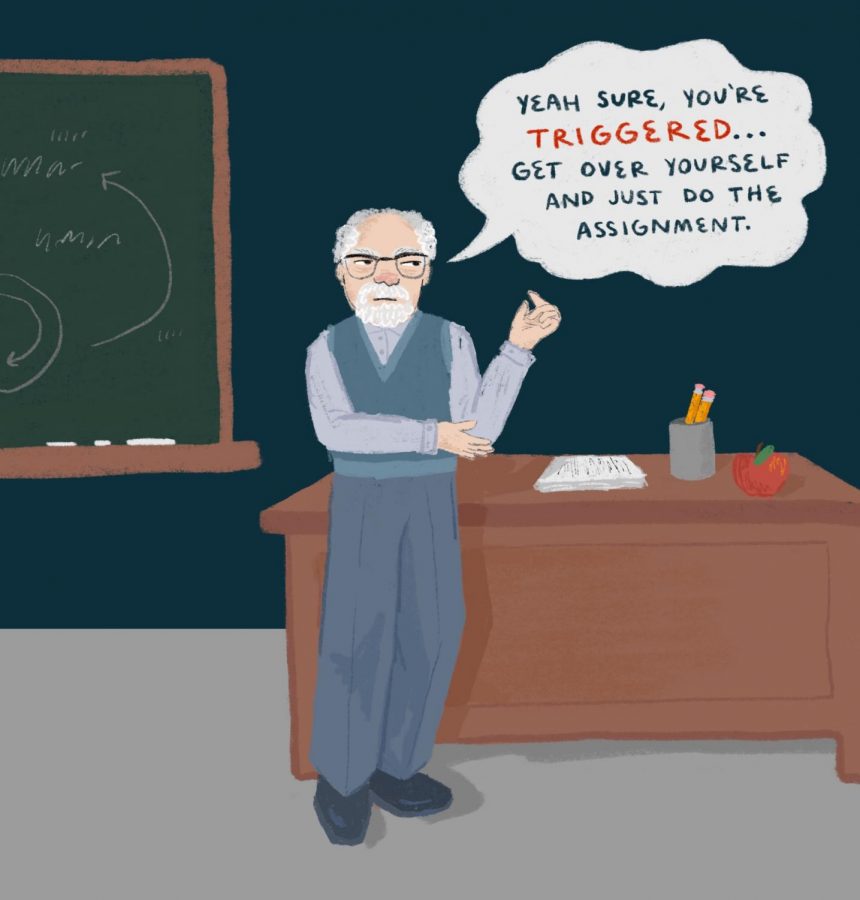Critics of trigger warnings are missing the point
March 22, 2019
“How the new political correctness is ruining education,” reads the cover of The Atlantic’s September 2015 issue, as a lighter sets the words aflame. It’s referring to the article “The Coddling of the American Mind” by Jonathan Haidt and Greg Lukianoff, which makes the case against trigger warnings in the classroom.
The story, which drew a significantly wider audience to the trigger warning debate, was one of many decrying the safe space/trigger warning movement as students who, in so many words, were weak or lazy or simply just didn’t want to be challenged. Haidt and Lukianoff depict university professors as victims of the oversensitive, irrational psyche of the modern-day college student, constantly fearing the “online mobs” students might stir up against them.
But, what Lukianoff, Haidt and many others are missing is that the trigger warning debate isn’t about laziness or political correctness at all. It’s about helping to remedy the growing mental health crisis in our schools, with one in five young people showing symptoms of a mental health disorder, according to the CDC, and the continuing institutional disregard for that crisis by those in power.
Exacerbating this problem, Haidt, Lukianoff, and many other academics reinforce the already monstrous stigma around mental health by propagating ideas that belittle the young adults fighting for trigger warnings and safe spaces. Dismissing and invalidating the concerns of young people does not make educational institutions any more effective or help young people become adults and toughen up, as many claim. What it does do, however, is guarantee that a decades long silencing of those speaking out against corrupt educational institutions continues without resistance.
The history of trigger warnings contributes to how this stigma developed. The first uses of trigger warnings were primarily on feminist blogs and forums, warning readers about discussion of sexual harassment or assault. However, the idea of trigger warnings in education didn’t seem to reach mainstream audiences until about 2014, due to many universities taking stances on their place in the classroom. Oberlin, for example, endorsed trigger warnings in a 2014 resource guide on sexual assault, but quickly amended their stance following backlash from faculty and media. More and more universities and academics became involved in the discussion, each taking increasingly polarized stances. Soon, the original intention, which mainly stemmed from avoiding triggering those with Post Traumatic Stress Disorder, was lost among shouts of “the embarrassing fragility on college campuses” from The Washington Post and “free speech trumps trigger warnings” from The Orion.
Some students and educators still fought for trigger warnings and tried to reiterate their importance in regards to the safety of students. But, politicization had taken over the conversation, with headlines like “Trigger warning: Either you’re for free speech or you’re not” from The Boston Globe. “Political correctness” and “freedom of speech” became buzzwords, as voices trying to advocate for real mental health reform were forced to the background. This is not to say that people stopped fighting, or that there weren’t as many people for trigger warnings as there were against — as it’s impossible to find exact numbers — or even that first amendment and political correctness debates aren’t important topics to have dialogues about. But using trigger warnings to have those debates is extremely misguided. Discussions took on a life of their own and became guided by media and academics who seemed to have little to no regard for the actual mental health issues that started the conversation in the first place.
Ultimately, trigger warnings are necessary so that students feel safe at school. A stable classroom environment, among other things, is essential for learning to occur. There is nothing more important than students’ safety. This does not mean that every single text we read or video we watch needs to be preceded by a trigger warning, just for topics that are commonly triggering of PTSD (for example: sexual assault, gun violence, domestic violence). Of course, there is no way to provide trigger warnings for every single instance that a student might be triggered. However, it is the responsibility of educators to create a sense of comfortability in their classroom, and using warnings for common triggers is one important way to do this. This trigger warning does not necessarily mean that the student will never be expected to learn whatever the teacher is teaching using the triggering material, but it gives students a heads up for what type of material will be presented to them so they can prepare emotionally and, if needed, use resources in school or otherwise. If a student is triggered by material, teachers should work to educate that student on the concepts, without using that triggering material.
For example, in one of my classes this year, we watched 12 Years a Slave, which chronicled the life of a free man who was captured and forced into slavery in the south. The movie included graphic scenes of violence, gore and sexual assault along with frequent use of racial slurs. This all could be very triggering for many students even with trigger warnings, but my teachers did not provide any. I couldn’t even focus on the movie because of these graphic scenes and felt extremely uncomfortable during most of the movie, but I also felt like I couldn’t step out of the room because my teachers didn’t offer that opportunity. As a white person, I understood the necessity of me to stay engaged throughout the film; however, I felt too overwhelmed by some of the graphic scenes to the point that I wasn’t able to be fully present for the potential educational impact. Also, the film’s illustration of American racism and its relationship to violent language could have triggered students of color in ways that I wouldn’t have been triggered.
Senior Anna Ter Molen perceives that “there’s a big lack of trigger warnings at ETHS.”
In one instance, Ter Molen was in a class this year that was showing a movie with a graphic scene of sexual assault.
“I literally had to walk out of the room,” she said. “It was horrible. [My teacher] gave no trigger warning at all.”
If a student is having a panic attack, high levels of anxiety, or is completely disengaged due to the content of a lesson, there is no logical sense in forcing them to engage and complete the work. None of the material will stick, the student will likely resent the teacher for making them relive a traumatic experience, and it will probably cement the idea in that student’s mind that their teacher cares more about them completing work then their actual wellbeing.
These are the actual issues we need to be reckoning with: how to make school an emotionally safe environment for everyone, how to reach students and help them learn even if the material is triggering, and how to advocate for ourselves, as students in a space that is dominated by adults in power, when we feel unsafe or threatened. We as students are undoubtedly in a vulnerable position when trying to advocate for ourselves, especially regarding mental health. Thus, it is imperative that teachers are receptive to our concerns and help us, not hurt or invalidate us.
There is also a common misperception among some educators that trigger warnings will actually worsen students’ anxieties by allowing them to remain unconfronted. But, trigger warnings do not give students a pass to completely disengage from discussions around triggering topics, just allow them to emotionally prepare for those discussions and step out if need be. While the intentions behind having open discussions of trauma to destigmatize those events are good, many students do not feel comfortable exposing themselves to their classmates and teacher in that way, especially in an uncontrolled environment with no mental health professionals present. In fact, if a student was forced to relive trauma in a setting that could not support the extreme emotions that comes with that, the student could actually be further traumatized.
In short, trigger warnings are not about censorship. They are not about free speech or being “politically correct.” These ideas about trigger warnings are merely skewed and incorrect sentiments shaped by the media and academics. Discussions about trigger warnings are not the time to have those conversations (not that those invoking such phrases seemed to be very willing to have a conversation in the first place). This diversion served as a way to ignore the pressing issue behind trigger warnings, which is the lack of mental health support in educational institutions and the overwhelming need for that support. It is disappointing, but not surprising, that even with a topic so clearly relating to mental illness at its core, those original ideas became so lost.










